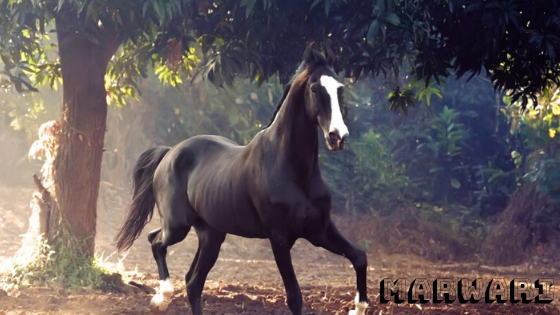Marwari horses are recognised for their astounding beauty,
and has now become a dignified animal for their owner. Today, these horses find
their way into homes and farms for the people of India, and is progressively
being used in horse shows and equestrian sports by its owners. The Marwari
desert horse continues to be the preferred animal across India because of its
inherent hot-blood and smooth gait. The Marwari horse has attained great
commercial value, and therefore, many reputed breeders are breeding an
admirable stock across India. These horses have been threatened by extinction,
so the Government of India has banned all export in the past. The horse
societies are urging the Government to lift the ban, thus recommencing export
to the world of this beautiful and loyal Marwari horse.
History:
The history of the breed begins in the 12th century in the
Manwar region of India. The local rulers, the Rathores, started breeding these
horses for use in wars as they had noticed how brave and loyal they were.
Although the exact parent breeds of the Marwari are unknown, it has Arabian
blood and is related to the Kathiawari breed. Although the breed was highly
valued throughout the centuries, early on in the 20th century interest in it
was lost and it reached the brink of extinction. The renewed tourist interest
in India however, contributed the most to the breed's swift recovery. In 1995
the Marwari was introduced in the United States.
How to Recognize a Marwari Horse:
The beautiful creatures are recognisable by their curled
ears, lean frame, and long legs. They are common among the people of India and
are often kept as pets for riding or as work animals.
One of the most distinctive features of the Marwari horse is
its long inward curling ears which are taken as a sign of a good temperament.
The breed tends to stand around 15 to 16 hands high
depending on the region of India that the individual horse originated from.
They come in all colours and have a long and relaxed ambling
gait that is poetic to watch.Some say that they are similar to the Kathiawari
breed from the region of the same name.
Today the horses are kept professionally for competitions
and as pets. Many can be bought on the market - and some are listed on the
Internet for sale.
The horses are categorised by the Indigenous Horse Society
of India which maintains strict standards for the breed.
Personality:
Marwari horses have unique performance traits & it is
most genetically distinct breed. Many of needs of Horse owners can be
accompanied by this horse breed as they can perform various tasks very well.
Careful and correct training of these horses make them extra ordinary partners.
They are distinguishable because of their environment adaptability. These
horses are known for their loyalty unto death with unbreakable spirit of
courage in battles.
Horse Care and Feeding:
These horses have an efficient digestive system, and do not
need as much fat and carbohydrates as most other horses. They are used to
having free range and if confined to a stall, they must be given exercise
regularly. They are social and aristocratic, and will not tolerate
inattentiveness.
Common Health Problems:
The Marwari horses are extraordinarily hardy and thrive in a
sparse, hot, environment. If they are to be kept in a cold weather climate,
they must be given time to acclimate gradually. They have very few soundness
problems.
Availability:
There are currently only a few Marwari in the U.S. The
Marwari Bloodlines Dundlod, and Marwari Bloodlines Chappaquiddick are centers
for information on the purchase of the Marwari horses, breed information,
bloodline registration, shows, competitions and adventure horse safaris. More
information concerning purchasing one of these lovely horses can be found from
the Indigenous Horse Society of India.
Interesting Facts:
- The Marwari horse has inwardly turned ear tips. He reminds you of a large cat, the way his ears turn inward. His head is often depicted in horse art because of the unique and graceful shape of his ears. In fact, some artists don’t even realize they are using the shape of the Marwari horse, specifically. The horse is often confused for the Arabian horse, from which he is descended from.
- The Marwari is technically considered to be a pony, averaging 14 hands high. There is still some flexibility in their height, due to parentage, but the average is typically around 14 hands and this makes them small enough to be considered a pony, rather than a horse.
- There is a legend surrounding the first Marwari horses. It is said that a ship was wrecked off the Indian coast and that 7 original Arabian horses bred with Marwari ponies to create the Marwari horses that we have today. This is the legend, whether it is true or not is another matter.
- It was during the British Raj period in India’s history when the Marwari nearly became extinct. In fact, at that time, the horse was openly made fun of for its ears that took an inward turn. Thankfully, in 1995 the breed began making a comeback and is once again in favor in India. It's revered as history and folklore in the country of India now. The breed seems poised to remain steadily on the uprise.
Reference:
https://www.horseclicks.com/community/advice/horse-breeds/10-amazing-facts-about-the-marwari-horse
http://www.mesopet.com/horse-breeds/marwari-20008.htm
https://animal-world.com/horses/Light-Horse-Breeds/Marwari.php
https://www.ponynhorse.com/breed/Marwari%20Horse.html
https://pethelpful.com/horses/Horses-in-India-The-native-Marwari-horse
http://revantamarwarihorses.com/breed-info/



















I loved reading the above article. It's such a great lesson, and your explanation is greater than it . Your site is far informative and effective to those who are in need of more teaching techniques and materials on Horse Breeds.Keep up the good work .
ReplyDeletewhat is the feed of the newfoundlands dogs??
ReplyDeletehttps://lovepetslife.online/2020/10/06/newfoundland_dog/
Awesome post on the Marwari Horse. It's really a unique horse a one of its kind. Great information you got there. Thanks.
ReplyDelete